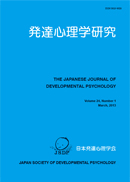Volume 23, Issue 2
Displaying 1-10 of 10 articles from this issue
- |<
- <
- 1
- >
- >|
-
Article type: Article
2012Volume 23Issue 2 Pages 123-133
Published: June 20, 2012
Released on J-STAGE: July 27, 2017
Download PDF (1849K) -
Article type: Article
2012Volume 23Issue 2 Pages 134-144
Published: June 20, 2012
Released on J-STAGE: July 27, 2017
Download PDF (1403K) -
Article type: Article
2012Volume 23Issue 2 Pages 145-157
Published: June 20, 2012
Released on J-STAGE: July 27, 2017
Download PDF (1607K) -
Article type: Article
2012Volume 23Issue 2 Pages 158-169
Published: June 20, 2012
Released on J-STAGE: July 27, 2017
Download PDF (1477K) -
Article type: Article
2012Volume 23Issue 2 Pages 170-179
Published: June 20, 2012
Released on J-STAGE: July 27, 2017
Download PDF (1359K) -
Article type: Article
2012Volume 23Issue 2 Pages 180-190
Published: June 20, 2012
Released on J-STAGE: July 27, 2017
Download PDF (1317K) -
Article type: Article
2012Volume 23Issue 2 Pages 191-201
Published: June 20, 2012
Released on J-STAGE: July 27, 2017
Download PDF (1447K) -
Article type: Article
2012Volume 23Issue 2 Pages 202-213
Published: June 20, 2012
Released on J-STAGE: July 27, 2017
Download PDF (1520K) -
Article type: Article
2012Volume 23Issue 2 Pages 214-223
Published: June 20, 2012
Released on J-STAGE: July 27, 2017
Download PDF (1126K) -
Article type: Article
2012Volume 23Issue 2 Pages 224-232
Published: June 20, 2012
Released on J-STAGE: July 27, 2017
Download PDF (1143K)
- |<
- <
- 1
- >
- >|
